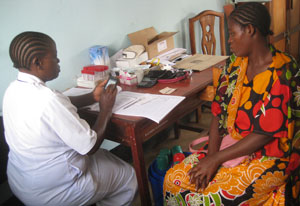Chronic diseases threaten progress against HIV/AIDS: Scientists propose urgent NCD research agenda
September / October 2014 | Volume 13, Issue 5

Photo by David Rochkind
Scientists say the chronic, noncommunicable disease
research agenda requires urgent attention, as more
Africans survive HIV only to be struck by an NCD.
The global success in bringing antiretroviral treatment to HIV-infected patients in the developing world has brought a new set of health challenges. Many patients once condemned to death by AIDS now suffer from noncommunicable diseases (NCDs) related to the infection itself, the drugs used to treat it, or the simple process of aging, an international group of researchers write in a
special issue of
JAIDS: Journal of Acquired Immune Deficiency Syndromes.
Estimates indicate that chronic illnesses have already overtaken infectious diseases as the main killers in the developing world. Increasing rates of NCDs among people with HIV, if unaddressed, "may set back or even reverse the impressive health gains achieved over the last decade," according to the authors.
In a series of eight articles and two commentaries, the scientists lay out a research agenda to determine the scope of the chronic illnesses and study the most efficient and cost-effective ways to tackle them. They suggest leveraging the existing HIV treatment infrastructure to study and treat problems such as tuberculosis, cancer, heart and lung disease, kidney disease, diabetes, mental illness and gastrointestinal disorders. All of these conditions can be comorbidities associated with HIV-related illness, whether the virus is treated or not, the authors write.
The publication grew out of a 2013 conference of international experts held at the Center for Global Health Studies at NIH. While the bulk of the supplement concerns circumstances in sub-Saharan Africa, two essays describe similar challenges in low-resource settings in Asia, and in Latin America and the Caribbean.
Studies in high-income countries indicate that a variety of NCDs are more common in HIV-infected populations. While the same is likely true in poorer countries, data that compare prevalence of these conditions among HIV-infected and non-infected populations are seldom available. In developing countries, co-infections that weaken immune systems and complicate treatment, as well as delays in diagnosis and treatment, may lead to different, sometimes larger distributions of these disorders, the authors suggest. About 8 million Africans currently receive antiretroviral therapy (ART), yet little is known about the impact of these drugs, many of which are harsher than comparable medications used in wealthy countries. In addition, there are few studies that compare the burden of chronic illness between people who are HIV-positive and those who are not infected.
Research will play a "critical role" in providing the evidence, strategies and tools required to deal with this emerging challenge, said the authors, who call for visionary scientific leadership, increased research capacity and the breakdown of disciplinary silos. They also recommend existing HIV clinical databases be expanded to include measurements of risk factors for chronic illness, such as body mass index and protein in the urine. Screening for depression and cervical cancer could also be integrated into HIV care, the authors said, since both take a huge toll in sub-Saharan Africa.

Photo courtesy of Dr. Marc Mitchell
Africa's HIV care delivery platform should be leveraged
to diagnose and treat the rising tide of chronic diseases,
such as cervical cancer, scientists suggest.
The authors suggest a number of complex health and implementation science topics in developing countries that merit further study, including:
The lessons learned from the integration of tuberculosis care into HIV treatment should be examined to develop optimal strategies to combat NCDs.
Virally triggered cancers associated with weakened immune systems are common - among them anal cancer, liver cancer and Hodgkin disease - but the epidemiology of HIV-associated cancers is not well studied.
ART is known to increase the risk of heart failure and other cardiopulmonary conditions in high-income countries but little is known about the impact in low-resource settings, where individuals may face additional risk factors such as air pollution.
Depression, alcohol abuse and cognitive disorders are prevalent in people living with HIV but the diagnostic tools in LMICs are inadequate and require further research.
Kidney disease - whether caused by treatment toxicities or opportunistic infections - is on the rise and registries should be established to study occurrence and severity of side effects of ART.
The NIH meeting on HIV comorbidities was jointly chaired by Dr. Sten Vermund of Vanderbilt University School of Medicine and Dr. K. M. Venkat Narayan of Emory University's Rollins School of Public Health. Attendees included representatives of nine NIH Institutes and Centers, as well as the WHO, USAID, CDC, the World Bank and the Office of the Global AIDS Coordinator at the U.S. Department of State. The session was hosted by the NIH Office of AIDS Research and Fogarty.
Conference participants agreed the impressive resources and dedication used to battle HIV in recent decades must now be enhanced to also diagnose and treat NCDs in HIV-infected populations.
"Just as the advent of widespread antiretroviral treatment demanded a seismic shift in global human capacity and health systems for the emergency response to HIV, emerging NCD comorbidities among those with HIV in lower- and middle-income countries will demand no less," note Narayan and colleagues.
There is also consensus that sustained investment and attention would be required to overcome the complicated problems involved. Priority research areas include defining the burden of NCDs today and in decades to come, understanding the prevalence and importance of modifiable risk factors, evaluating effective and efficient treatment and care strategies at the individual and health systems levels, and determining cost-effective preventive interventions.
"The papers in this supplement articulate an agenda from which we can begin to address the spectrum of research, training, effective implementation and evidence-based policy needed to confront this devastating new challenge of chronic illness among those living with HIV in developing countries," according to Fogarty Director Dr. Roger I. Glass.
More Information
- Access articles from the September 1, 2014 supplement to
Journal of Acquired Immune Deficiency Syndromes (JAIDS):
- Access a collection of global health research resources on
chronic, noncommunicable diseases (NCDs) and
HIV/AIDS.
- Related NIH news:
To view Adobe PDF files,
download current, free accessible plug-ins from Adobe's website.